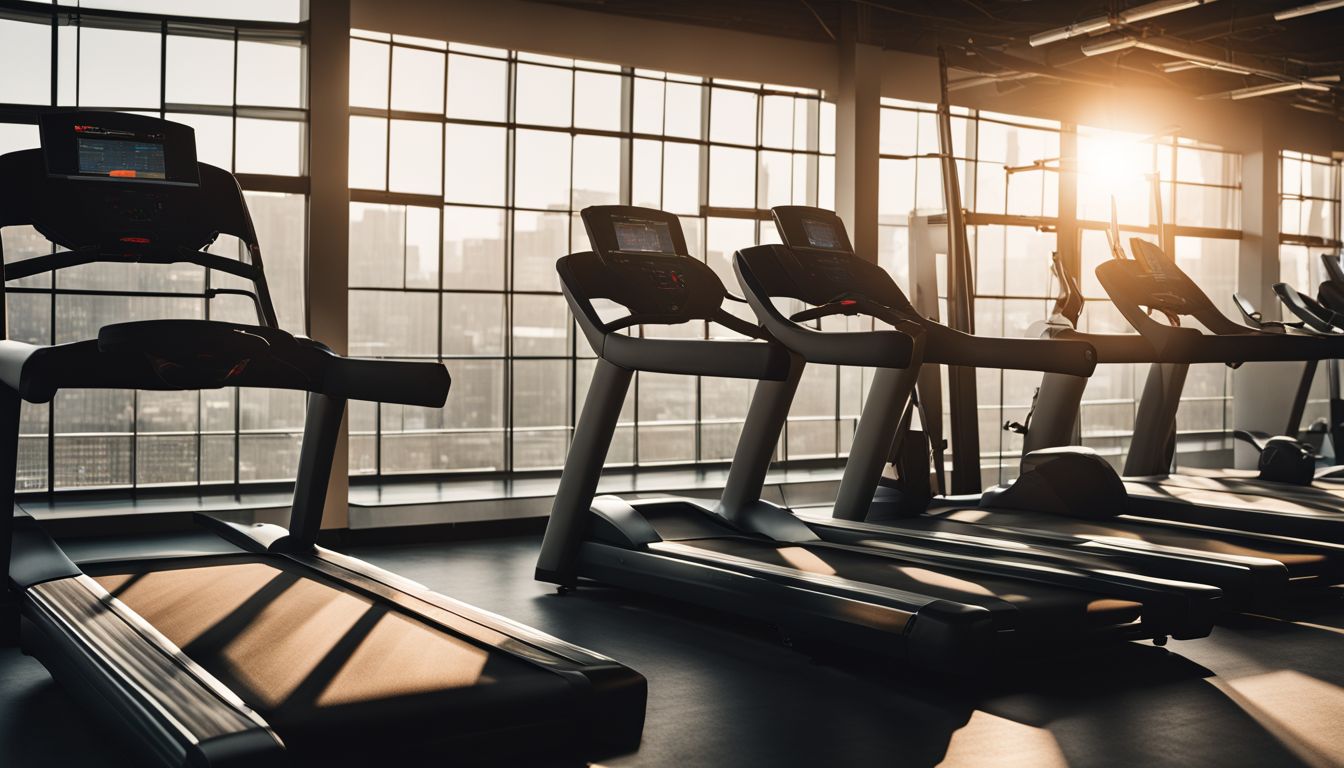Struggling to burn that stubborn body fat? Fasted cardio could be a game-changer for many in their weight loss journeys. This blog post unpacks the pros and cons of sweating it out on an empty stomach – from potential fat loss benefits to possible muscle risks.
Key Takeaways
- Fasted cardio can lead to more fat burn because your body uses stored fat for energy on an empty stomach. Yet, it may also cause muscle loss and decreased workout intensity.
- Exercising without eating first might improve insulin sensitivity and help control blood sugar levels, possibly reducing the risk of type 2 diabetes.
- It’s not for everyone; people with certain medical conditions or those new to exercise should avoid it. Muscle builders and pregnant women are also advised against fasted cardio.
- To do fasted cardio safely, stick to lighter workouts, stay hydrated with sports drinks, have a snack before bed if needed, and refuel with a balanced meal afterward.
- While some studies support the potential weight loss benefits of fasted cardio, others show no significant difference compared to fed workouts – overall calorie intake vs. expenditure is key for losing weight.
Understanding Fasted Cardio

Fasted cardio means you hit the gym before eating breakfast. Your body works differently on an empty stomach. With no food to use for energy, it starts burning fat right away. This sounds great if you want to lose weight.
Some people believe that fasted cardio can help shed pounds faster than regular workouts. They say working out without any food in your system makes your body burn more fat during exercise.
Yet, opinions vary and not all experts agree on this.
In a fasted state, blood sugar levels are low because the last meal was hours ago, usually before sleep. The body then has to find another source of energy – which is often stored fats – so it burns those instead of using glucose from a recent meal.
Doing cardio without having eaten may increase fat oxidation; that’s when fatty acids get broken down for energy. But remember that while some fat is burned this way, how much gets used depends on many factors like workout intensity and individual metabolism.
The Potential Benefits of Fasted Cardio

Engaging in fasted cardio might be more than just a fitness trend; it’s a practice with intriguing benefits that are capturing the attention of exercise enthusiasts and researchers alike.
From tapping into fat reserves to potentially kickstarting your metabolism, this method could unlock new levels of efficiency in your workout regimen.
Greater Fat Loss
Fasted cardio can help you burn more fat. Your body turns to stored fat for energy because your stomach is empty. This means you might lose more body fat during these types of workouts.
Research backs this up, showing that people often burn more fat when they do cardio without eating first.
Some studies find that fasted exercise improves how well your body burns fat for fuel. This could lead to better overall results in shedding unwanted pounds, especially around the belly area.
Still, not all research agrees on just how effective fasted cardio is for long-term weight loss success. It’s important to look at your own goals and see if this approach fits into your workout routine.
Improved Insulin Function
Working out on an empty stomach can kickstart your insulin to work better. This means your body becomes more effective at managing sugar levels in your blood. For those worrying about type 2 diabetes or looking to keep their blood sugar stable, fasted cardio might be a good choice.
It helps the muscles respond to insulin better, pulling glucose from the blood more efficiently.
This can lead to less chance of getting high blood sugar and storing extra fat. Your body learns to use energy smarter, especially when you haven’t eaten before exercising. Doing cardio while fasting could make your cells more sensitive to insulin, which is great for overall health and weight management.
Possible Reduction in Caloric Intake
Fasted cardio could lead to eating fewer calories throughout the day. Some people find they aren’t as hungry after a morning workout on an empty stomach. This might help create a calorie deficit, which is key for weight loss.
Others may make better food choices post-exercise. They want to keep that healthy feeling going, so they reach for nutritious foods instead of high-calorie options. This can further support their efforts to shed pounds and stay fit.
The Drawbacks of Fasted Cardio
While fasted cardio can be an intriguing approach to fitness, it’s not without its potential pitfalls—understanding these could make all the difference in how you tailor your workout regime for optimal results.
Possible Hindrance to Muscle-Building
Fasted cardio might not be the best friend of your muscles. Cutting out food before a workout can lead to less muscle being built. Your body needs energy when you exercise. It usually gets it from what you’ve eaten recently.
If you haven’t eaten, your body may start breaking down muscle for fuel. This happens because of a process called gluconeogenesis.
Lifting weights or doing resistance training on an empty stomach could be even trickier. These activities are all about building and repairing muscle tissue. Without enough dietary protein and energy from food, these processes don’t work as well as they should.
So if gaining muscle is your goal, think about eating something before lifting those dumbbells!
Potential to Impair Performance
Fasted cardio might sound like a solid plan for losing fat, but it can come with drawbacks. Without food, your body may lack the energy needed for peak performance. This means you could tire out faster and not work as hard as you usually do when eating beforehand.
Running on empty affects how well your muscles work. Glycogen stores are low, which makes it tough to keep up strength during workouts. You risk muscle loss, because if your body needs more fuel than what’s in your fat reserves, it starts breaking down muscle protein instead.
Plus, intense physical activity without proper hydration can lead to dehydration quickly.
Who Should Avoid Fasted Cardio?
Fasted cardio isn’t for everyone. Some people may face risks and should steer clear of it.
- People with conditions like low blood sugar should avoid fasted exercise. It can make their symptoms worse.
- If you have low blood pressure, skip fasted cardio. You might feel dizzy or faint during your workout.
- Pregnant women need to keep away from this practice—it’s not safe for them or the baby.
- Individuals working on building muscle mass might find fasted cardio counterproductive.
- Those new to fitness shouldn’t jump into fasted exercise; start with regular workouts first.
- Anyone with a history of eating disorders needs to be cautious. Fasted workouts could trigger unhealthy habits again.
- Athletes training for endurance events need energy. They should eat before long and intense sessions.
- People with diabetes require careful blood sugar management. Fasted workouts could disrupt this balance.
- If you’re underweight, your body needs nutrients for basic functions—avoid exercising on an empty stomach.
- Folks who get very dehydrated should eat and hydrate before exercise to stay safe.
Guidelines for Safely Implementing Fasted Cardio
Dipping your toes into the world of fasted cardio requires a blend of caution and wisdom; it’s all about threading the needle between reaping potential benefits and sidestepping risks.
To navigate these waters safely, there are some strategic moves you’ll want to consider — from timing to fueling strategies that keep your engine running smoothly without undoing the fasted state’s unique advantages.
Save it for Lighter Workouts
Choose fasted cardio for your easier sessions. Pick a gentle jog or a brisk walk rather than sprinting or heavy lifting. This helps to keep your blood sugar in check and prevent you from feeling weak or dizzy.
When you work out without eating, it’s best to avoid pushing too hard.
Stick to shorter or moderate steady-state exercises when fasting. That means going at a pace where you can still talk but are working up a sweat. You’ll burn fat without the risk of running out of energy too quickly.
Fasted workouts should be light enough that you finish feeling good, not exhausted.
Consider a Sports Drink
Keeping your workouts light is smart, but staying hydrated is key. Sip on a sports drink to keep energy levels up and muscle fatigue at bay during fasted cardio. These drinks are crafted with the right mix of carbohydrates and electrolytes.
They help you stay strong and steady throughout your workout.
Hydration matters, especially when you’re pushing through a sweat session without prior fueling. Sports drinks quickly replenish what your body loses, keeping blood sugar stable and blood pressure in check.
They’re not just for quenching thirst; they also restore glycogen stores vital for muscle recovery post-exercise. For lasting endurance and better performance, consider making a sports drink part of your routine while tackling those intense or prolonged workouts.
Eat a Bedtime Snack
Eating a bedtime snack can keep your energy up and protect your muscles while you sleep. You don’t want to wake up hungry or with low blood sugar after fasted cardio. Choose snacks that are balanced, like a mix of protein and carbs.
This combo helps to repair your muscles and refuel your body.
Your snack should be eaten about an hour before bed. This timing gives your body enough time to digest the food properly. Good options include yogurt with fruit or peanut butter on whole-grain toast.
These foods will help keep you full overnight and support weight loss efforts. They also aid in better sleep, so you’re ready for tomorrow’s workout!
Refuel Afterward
After your fasted cardio session, grab a balanced meal or snack. This helps your body recover and rebuilds the muscles you’ve just worked out. Protein-rich foods mixed with some carbs are an excellent choice to kick-start muscle repair and replenish energy stores.
Drinking plenty of fluids is also key for refueling. Water or a sports drink can replace lost electrolytes during exercise. Make sure not to skip this step—it’s crucial for keeping your body hydrated and functioning well after working out!
Other Types of Exercise While Fasting
Fasted strength training can help you keep muscle while shedding fat. Lifting weights on an empty stomach might burn more stored body fat for energy, preserving those hard-earned muscles.
It’s key to listen to your body and not push too hard during these sessions.
You could also try low-impact exercises like yoga or walking. They’re easier on your body when you haven’t eaten. These activities support flexibility, balance, and stress reduction without heavily stressing your energy reserves.
Always stay hydrated and focus on how you feel throughout the workout to avoid overexertion.
Comparing Fasted Cardio with Other Workouts for Weight Loss
When it comes to shedding pounds, not all workouts are created equal. Fasted cardio steals the spotlight for some, but how does it truly measure up against other weight loss warriors like high-intensity interval training or a splash in the aqua fitness pool? Let’s dive into the evidence and see which regime reigns supreme for torching calories.
Is Aqua Fitness Good for Weight Loss?
Aqua fitness is more than just a fun splash in the pool—it’s a powerful way to shed pounds. With every move, your muscles work harder because water adds resistance. This means you burn calories and lose weight while also taking it easy on your joints.
It’s great for overweight individuals or anyone wanting to lower their body fat percentage.
Jumping into an aqua cardio workout can kickstart your metabolism as well. In water, even simple exercises become challenging. You push against the resistance without sweating it out too much! Combining this with a healthy diet can lead to significant loss of weight, making aqua fitness an effective part of any exercise routine aimed at reducing total fat mass.
Does Fasted Cardio Lead to Greater Weight Loss?
Fasted cardio might sound like a surefire way to lose weight, but the truth isn’t so clear-cut. Some research shows that working out on an empty stomach can tap into fat stores. However, it’s not guaranteed you’ll see bigger drops in the scale numbers.
Your body might burn more dietary fat during fasted exercise, but this doesn’t mean you’re losing body fat faster overall.
Other studies suggest no significant difference between fasted and fed workouts when it comes to shedding pounds. What really matters is how many calories you burn versus how many you take in throughout the day.
If your focus is weight loss, controlling your diet and staying consistent with any form of aerobic workouts could be just as effective as sweating it out on an empty stomach. Now let’s explore what science says about why or why not this method works.
The Science Behind Fasted Cardio
Fasted cardio works by tapping into your body’s fat stores. It targets these energy reserves because you exercise without recent food intake. Your glycogen levels are low first thing in the morning before breakfast, so your body turns to fat for fuel quicker than if you had eaten.
During aerobic exercise like running or cycling, this can mean more fat burned.
Scientists study how fasted cardio affects lipolytic enzymes that break down fats. They also look at insulin sensitivity and how it changes when you work out on an empty stomach. Lower insulin levels help your body use fat instead of glucose for energy.
This could lead to improved body composition over time—less fat and a healthier weight—especially when combined with a balanced diet and regular activity.
Conclusion
Let’s sum it up—fasted cardio has its ups and downs. It might help you burn more fat and get your insulin levels in check. But, watch out—you could lose some muscle or not have enough juice to go all out.
If you’re thinking about trying it, remember to listen to your body and think about what you really want from your workouts. Follow the tips for doing it safely, and always make sure to refuel once you’ve finished breaking a sweat!
FAQs
1. What is fasted cardio and how does it work?
Fasted cardio means doing cardiovascular exercises on an empty stomach, often after intermittent fasting. The idea is that your body will burn more fat for energy because you haven’t eaten.
2. Can fasted cardio help me lose weight faster?
Some believe fasted cardio helps with weight loss since it may increase fat burning, but scientific evidence isn’t firm on this. It can vary based on your body mass index and overall health.
3. Are there any risks to doing fasted cardio workouts?
Yes, there can be risks like low blood glucose or feeling faint if your body isn’t used to exercising without food fueling it first – particularly if you have diabetes management issues or insulin resistance.
4. Does doing cardio in a fasted state improve my metabolism?
The impact of fasted cardio on metabolic rate isn’t clear-cut – while some say it boosts the resting metabolic rate, others argue the effects are minor compared to regular fed exercise.
5. Should I consider my BMI before trying fasted workouts?
Absolutely! Your body mass index (BMI) matters because those with higher BMIs might see different effects from those who aren’t obese, including how they manage their exercise science routine and dietary plans.
6. How do I know if fasted aerobic training fits into my lifestyle?
Consider consulting peer-reviewed studies and talk with health experts about whether endurance workouts after fasting aligns with your fitness goals – remember to keep tabs on how you feel during sessions using tools like food diaries or even just checking in with yourself.




Leave a Reply